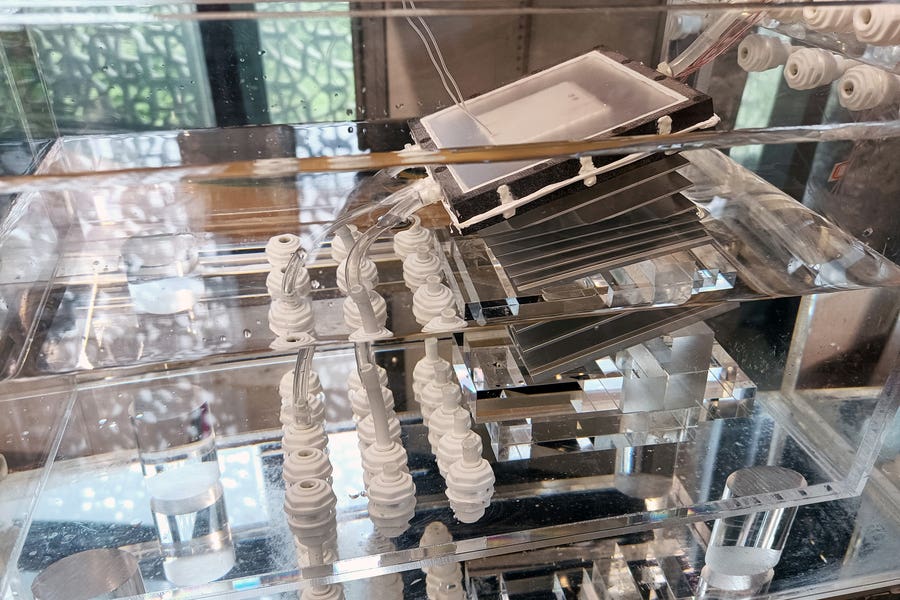Solar-powered desalination system is cheap enough to solve the world’s drinking water shortage
MIT and Shanghai researchers created a solar desalination system that transforms seawater into affordable drinking water, using only sunlight.

A tilted ten-stage prototype is located into a “boat-like” reservoir. (CREDIT: Jintong Gao and Zhenyuan Xu)
Engineers at MIT and Shanghai Jiao Tong University in China are working on an innovative solar-powered desalination system to convert seawater into drinkable water. The system aims to provide clean water more affordably than tap water.
In a study published in Joule, the researchers outlined their design for a passive desalination device. This system uses natural sunlight to heat seawater, promoting evaporation and leaving salt behind. The water vapor is then condensed into pure drinking water.
What sets this system apart from others is its ability to avoid clogging by keeping the salt in motion. Salt accumulation can be a major issue in desalination systems, but the team’s design ensures the salt is continuously flushed out instead of building up and blocking the system.
The potential impact is significant. The researchers estimate that a device about the size of a small suitcase could generate 4 to 6 liters of drinkable water per hour. This small-scale system could supply enough water to meet the needs of a small family. At this scale, it could even provide cheaper water than tap water, according to Lenan Zhang, a research scientist at MIT.
“For the first time, it is possible for water, produced by sunlight, to be even cheaper than tap water,” Zhang said.
The long-term vision for the device includes off-grid applications. Coastal communities, where seawater is readily available but electricity is scarce, could benefit the most. Zhang and the team foresee this technology being scaled up to provide a reliable source of drinking water for remote areas, without relying on traditional infrastructure.
Related Stories
The research team includes MIT graduate student Yang Zhong and Evelyn Wang, a professor of engineering at MIT, as well as researchers from Shanghai Jiao Tong University. They have made significant strides toward overcoming challenges faced by previous desalination models.
Enhancing Existing Designs
This latest breakthrough builds on the team's earlier work. In their initial design, they created a multi-layer system where water would evaporate and condense, producing drinkable water. However, this early design had a problem: the leftover salt quickly built up, forming crystals that clogged the system after just a few days. Users would need to regularly replace parts, increasing the cost and reducing the efficiency of the device.
In a follow-up design, the team introduced a system that prevented the salt from settling. While this design succeeded in preventing clogs, it did so at the expense of water production. The new system had a lower desalination rate, limiting its overall effectiveness.
In their most recent iteration, the team successfully combined the best features of both previous designs. This version not only produces water at a high rate but also rejects salt efficiently. It achieves this by utilizing a multi-stage system of evaporators and condensers, similar to the original design, but with an added feature that enhances water circulation.
Jintong Gao, one of the team members from Shanghai Jiao Tong University, explained the mechanism behind the latest innovation. “We introduce now an even more powerful convection, that is similar to what we typically see in the ocean, at kilometer-long scales,” Gao said.
This enhanced circulation is inspired by a natural process known as “thermohaline” convection, which governs the movement of ocean water. It occurs when differences in temperature and salinity cause water to move in swirling patterns.
The research team mimicked this process in their design, allowing the water and salt to circulate continuously. By doing so, the system effectively prevents salt buildup, extending the life of the device.
“When seawater is exposed to air, sunlight drives water to evaporate. Once water leaves the surface, salt remains. And the higher the salt concentration, the denser the liquid, and this heavier water wants to flow downward,” Zhang explained. “By mimicking this kilometer-wide phenomenon in a small box, we can take advantage of this feature to reject salt.”
How the System Works
At the heart of the system is a simple yet effective design. A thin, box-like structure is topped with a dark material that absorbs sunlight. Inside, the box is divided into two sections: the top half for heating the water and the bottom half for condensing it. Saltwater flows into the top half, where the evaporator layer heats it using solar energy. As the water evaporates, it leaves behind salt, and the vapor is funneled to the bottom half, where it cools and condenses into drinkable water.
The system is designed to be passive, meaning it doesn’t require any electricity to function. It relies solely on the sun’s energy and natural circulation to move the water and salt. The box is tilted to encourage the water to swirl as it flows through the system. This motion brings the water into contact with the evaporator layer while also keeping the salt in circulation, preventing it from clogging the device.
The team tested prototypes with varying numbers of stages (layers) to measure the system’s efficiency. Each stage was tested with different types of water, including natural seawater and water with extremely high salinity—seven times saltier than seawater.
The results were promising. When scaled up to a square meter, the system was able to produce up to 5 liters of drinking water per hour. More importantly, it was able to desalinate water for several years without salt accumulating inside.
Given its durability and low operating cost, the system offers a new approach to solar desalination that is both affordable and sustainable. “We show that this device is capable of achieving a long lifetime,” Zhong said. “That means that, for the first time, it is possible for drinking water produced by sunlight to be cheaper than tap water. This opens up the possibility for solar desalination to address real-world problems.”
The technology has already attracted attention from other experts in the field. Guihua Yu, a professor at the University of Texas at Austin, praised the design for its ability to tackle the main challenges of desalination. “This is a very innovative approach that effectively mitigates key challenges in the field of desalination,” Yu said. “The design is particularly beneficial for regions struggling with high-salinity water. Its modular design makes it highly suitable for household water production, allowing for scalability and adaptability to meet individual needs.”
With funding support from the Natural Science Foundation of China, this research holds great promise for addressing global water scarcity issues. The team’s passive, solar-powered desalination device offers a practical solution for turning seawater into drinking water without the high costs and environmental impacts of traditional desalination methods.
As the technology continues to develop, it could provide clean water to millions of people worldwide, particularly in areas where freshwater resources are limited.
Note: Materials provided above by The Brighter Side of News. Content may be edited for style and length.
Like these kind of feel good stories? Get The Brighter Side of News' newsletter.
Joshua Shavit
Science & Technology Writer | AI and Robotics Reporter
Joshua Shavit is a Los Angeles-based science and technology writer with a passion for exploring the breakthroughs shaping the future. As a contributor to The Brighter Side of News, he focuses on positive and transformative advancements in AI, technology, physics, engineering, robotics and space science. Joshua is currently working towards a Bachelor of Science in Business Administration at the University of California, Berkeley. He combines his academic background with a talent for storytelling, making complex scientific discoveries engaging and accessible. His work highlights the innovators behind the ideas, bringing readers closer to the people driving progress.



